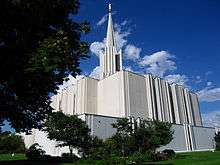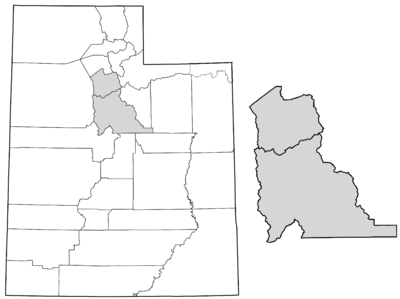Jordan River Utah Temple
| Jordan River Utah Temple | ||||||||||||||||||||||||||||||||||||||
|---|---|---|---|---|---|---|---|---|---|---|---|---|---|---|---|---|---|---|---|---|---|---|---|---|---|---|---|---|---|---|---|---|---|---|---|---|---|---|
| Closed for Renovation | ||||||||||||||||||||||||||||||||||||||
 | ||||||||||||||||||||||||||||||||||||||
| Number | 20 | |||||||||||||||||||||||||||||||||||||
| Dedication | 16 November 1981 by Marion G. Romney | |||||||||||||||||||||||||||||||||||||
| Site | 15 acres (6.1 hectares) | |||||||||||||||||||||||||||||||||||||
| Floor area | 148,236 sq ft (13,772 m2) | |||||||||||||||||||||||||||||||||||||
| Height | 219 ft (67 m) | |||||||||||||||||||||||||||||||||||||
| Preceded by | Seattle Washington Temple | |||||||||||||||||||||||||||||||||||||
| Followed by | Atlanta Georgia Temple | |||||||||||||||||||||||||||||||||||||
| Official website • News & images | ||||||||||||||||||||||||||||||||||||||
| ||||||||||||||||||||||||||||||||||||||
Coordinates: 40°33′58.08600″N 111°55′53.51520″W / 40.5661350000°N 111.9315320000°W
The Jordan River Utah Temple (formerly the Jordan River Temple) is the 20th operating temple of The Church of Jesus Christ of Latter-day Saints (LDS Church). Located in South Jordan, Utah, it was built with a modern single-spire design.
A site dedication and groundbreaking ceremony were held on June 9, 1979. The ceremony and dedication were presided over by church president Spencer W. Kimball. Instead of the usual small ceremonial shovel-full of dirt at the groundbreaking, Kimball used a large power scoop shovel to begin the building process. The temple was open to the public for tours September 29 through October 31, 1981. Over half a million people toured the temple during its open house.
On August 7, 2015 the LDS Church announced that beginning February 15, 2016, the temple closed for renovations that are anticipated to be completed during the latter part of 2017.[1]
Dedication

Marion G. Romney, a member of the church's First Presidency, dedicated the Jordan River Temple in fifteen sessions held during November 16–20, 1981. More than 160,000 members attended the dedicatory services. Thirty of those in attendance at the dedication were elderly men and women who had been at the historic dedication of the first temple in the Salt Lake Valley, the Salt Lake Temple. Most had been very young at the time but still remembered the event. The temple serves Latter-day Saints in Southern Salt Lake County, Utah. Geographically, it is the smallest LDS temple district in the world, but the temple is one of the church's busiest.
Features
The temple is the fourth largest LDS temple (but second-largest in Utah) and has a total of 148,236 square feet (13,771.6 m2), six ordinance rooms, and seventeen sealing rooms. The temple also has the largest capacity, with each ordinance room able to accommodate 125 people. The temple site is 15 acres (61,000 m2). The exterior of the temple is finished with cast stone with white marble chips. Unlike many of the temples, which are built mostly with tithing funds, the Jordan River Temple site was given to the church and all of its construction was paid for by members in the 134 stakes within the temple district. At the time, payment from local building funds was the established practice in the church, but was later abandoned in order to respond to the church's need for temples and church buildings in developing areas of the world.
Presidents
Notable presidents of the temple include H. Burke Peterson (1985–87); William Grant Bangerter (1990–93); LeGrand R. Curtis (1996–99); Ben B. Banks (2002–05); and Robert L. Backman (2005–08).
See also
- Comparison of temples of The Church of Jesus Christ of Latter-day Saints
- List of temples of The Church of Jesus Christ of Latter-day Saints
- List of temples of The Church of Jesus Christ of Latter-day Saints by geographic region
- Temple architecture (Latter-day Saints)
- The Church of Jesus Christ of Latter-day Saints in Utah
References
- ↑ "Jordan River Utah Temple Will Close for Extensive Renovation", Newsroom, LDS Church, 2015-08-07
External links
-
 Media related to Jordan River Utah Temple at Wikimedia Commons
Media related to Jordan River Utah Temple at Wikimedia Commons - Official Jordan River Utah Temple page
- Jordan River Utah Temple page
